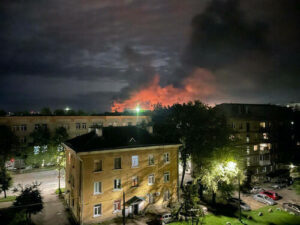
The attacks deep into Russia are bolder and more frequent.
At first, it looks like ordinary surveillance footage of a large military plane sitting on the tarmac. But then the wing catches fire. A second plane flickers across the screen, and in an instant its fuselage is engulfed in flames. Even in grainy black and white you can see the smoke billowing up into the night sky.
 Two Russian Ilyushin IL-76 strategic airlifters were destroyed by Ukrainian drones on Aug. 29 at Kresty air base in Pskov, Russia, at a cost of about $100 million to the Kremlin. Kresty is home to the 334th Military Transport Aviation Regiment, a seemingly well-fortified location close to Estonia’s southern border but over 430 miles from the battlespace in Ukraine. Two more IL-76s were also left badly damaged by the attack, perhaps beyond repair.
Two Russian Ilyushin IL-76 strategic airlifters were destroyed by Ukrainian drones on Aug. 29 at Kresty air base in Pskov, Russia, at a cost of about $100 million to the Kremlin. Kresty is home to the 334th Military Transport Aviation Regiment, a seemingly well-fortified location close to Estonia’s southern border but over 430 miles from the battlespace in Ukraine. Two more IL-76s were also left badly damaged by the attack, perhaps beyond repair.
The symbolism of this sortie was profound. The IL-76 is the type of transport plane Russian paratroopers flew on into Kyiv in an abortive attempt to decapitate the Ukrainian government in late February 2022, a mission Moscow and many Western analysts believed would take no more than 72 hours. Eighteen months later, Ukraine is not only “invading” Russia on a near-daily basis, launching long-range drones from Ukrainian territory, but also — and more embarrassingly for Moscow — using assets recruited by Ukrainian military intelligence (HUR) to launch short-range ones from within Russian. HUR’s popular and highly meme-able chief, Maj. Gen. Kyrylo Budanov, has confirmed that the latter method was used for the Pskov operation.
In fact, six different Russian regions were lit up on Aug. 29 by an unprecedented, multipronged attack whose other targets, successfully struck, included a fuel depot in Kaluga and a microelectronics factory in Bryansk, where components for Russian weapons systems are manufactured. Just a week earlier, on Aug. 22, Ukrainian saboteurs used quadcopter drones — weaponized versions of the type of hobbyist kit readily available for purchase — to take out a supersonic Tupolev Tu-22M3 Russian nuclear bomber on the tarmac at the Soltsy-2 air base, south of St. Petersburg. Soltsy-2 is over 370 miles from the Ukrainian border, meaning that any such unmanned aerial vehicle (UAV) would almost certainly have been launched from within Russia by HUR-recruited assets.
–From Michael Weiss and James Rushton of the UK’s New Lines Magazine
Photo of airport: Kyiv Post from Russian social media






